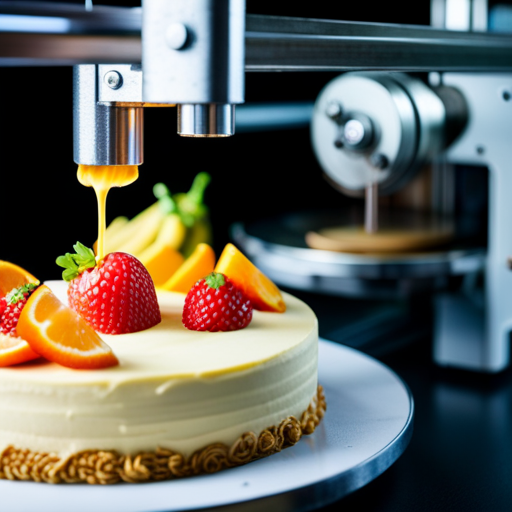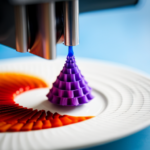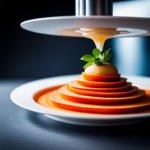As technology continues to revolutionize the way we consume and produce food, innovations in 3D printing have emerged as a game-changer in the food industry.
From personalized nutrition to sustainable food production, 3D printing technology is paving the way for enhanced food customization and culinary creativity.
This article explores the latest advancements in food 3D printing, shedding light on the future of dining experiences and the potential impact on the food industry.
Personalized Nutrition
Personalized nutrition is revolutionizing the way individuals approach their dietary needs by tailoring food choices to their specific health requirements and preferences. Customized diets are designed to address an individual’s unique nutritional needs, taking into account factors such as age, gender, weight, metabolism, and any existing health conditions. This approach marks a shift from traditional, one-size-fits-all dietary recommendations to a more tailored and effective dietary personalization.
The concept of personalized nutrition is gaining traction as advancements in technology and research allow for a deeper understanding of how individual genetic makeup and lifestyle factors influence dietary requirements. By leveraging this knowledge, nutritionists and healthcare professionals can create personalized dietary plans that optimize health outcomes and improve overall well-being. Furthermore, the rise of digital health platforms and mobile applications has made it easier for individuals to access personalized nutrition services, empowering them to make informed food choices that align with their specific health goals.
As personalized nutrition continues to evolve, it holds the potential to revolutionize the food industry by driving demand for customized food products and innovative dietary solutions. This trend reflects a growing awareness of the impact of dietary choices on health and underscores the significance of tailored nutritional approaches in promoting long-term wellness.
Enhanced Food Customization
Enhanced food customization builds upon the concept of tailoring dietary choices to individual health needs and preferences, utilizing advanced technology to create personalized food products with precision and efficiency. This innovative approach offers a myriad of benefits and possibilities, including:
-
Customized Flavors: 3D printing technology allows for the precise mixing and layering of ingredients, enabling the creation of custom flavors tailored to individual preferences. From subtle adjustments to bold, unique combinations, the potential for personalized taste experiences is vast.
-
3D Printed Textures: The ability to control the texture and structure of food through 3D printing opens new avenues for customization. This technology can produce varying textures within a single food item, catering to diverse sensory preferences and dietary requirements.
-
Nutritional Precision: Enhanced food customization facilitates the precise incorporation of essential nutrients and dietary supplements, ensuring that each personalized food product aligns with specific nutritional needs.
-
Tailored Portion Sizes: 3D printing technology allows for the creation of individualized serving sizes, accommodating diverse dietary requirements and promoting portion control.
As food 3D printing technology continues to advance, the potential for enhanced food customization is poised to revolutionize the way individuals interact with and consume food, ultimately contributing to a more sustainable and personalized approach to nutrition.
Sustainable Food Production
The advancement of food 3D printing technology has opened up possibilities for sustainable food production. One of the key areas where 3D printing is making a significant impact is in vertical farming. Vertical farming, enabled by 3D printing, allows for the efficient use of space and resources, minimizing the environmental impact of food production. Through this method, crops can be grown in vertically stacked layers, using soilless growth mediums and controlled environment agriculture techniques. This not only reduces the need for large areas of land but also minimizes the use of water and pesticides.
Furthermore, 3D printing technology has the potential to contribute to waste reduction in food production. By utilizing precise ingredient deposition, 3D printers can minimize food waste by creating intricate and customized food products with the exact amount of ingredients required. This can help in reducing overproduction and the disposal of unsold or unused food items.
As sustainable food production continues to evolve with the aid of food 3D printing technology, it is essential to consider its impact on culinary creativity and design.
Culinary Creativity and Design
An exploration into the intersection of culinary creativity and design within the context of food 3D printing technology reveals its potential to revolutionize the way food is conceptualized and presented. This innovative technology allows chefs to push the boundaries of culinary art and design, opening up new possibilities for creating visually stunning and intricately designed dishes.
The integration of digital recipes with 3D printing enables chefs to experiment with textures, shapes, and flavors in ways that were previously unattainable. Here are some key aspects to consider:
-
Customized Dining Experiences: Food 3D printing technology empowers chefs to craft personalized dining experiences tailored to individual preferences and dietary requirements.
-
Artistic Presentation: By leveraging 3D printing, chefs can transform ordinary ingredients into extraordinary culinary works of art, elevating the visual appeal of dishes.
-
Enhanced Precision and Consistency: This technology enables precise control over the composition and assembly of dishes, ensuring consistency in both taste and presentation.
-
Unleashing Creativity: Chefs can unleash their creativity by utilizing intricate designs and unconventional shapes to redefine the aesthetics of food, offering an entirely new dining experience.
The fusion of culinary art and design with food 3D printing technology represents a paradigm shift in the gastronomic world, offering a tantalizing glimpse into the future of food innovation.
Future Dining Experiences
Amidst the evolving landscape of culinary technology, future dining experiences are poised to be transformed by the integration of food 3D printing innovations.
Immersive dining, where guests are fully engrossed in a multisensory experience, is set to become more prevalent. With the advancement of food 3D printing, chefs can now create intricate, visually stunning dishes that not only appeal to the palate but also engage all the senses.
Imagine a dining experience where guests are enveloped in an atmosphere where the aroma of freshly printed delicacies wafts through the air, while visually captivating dishes are presented, and each bite tantalizes the taste buds with a burst of carefully curated flavors.
This integration of technology with culinary artistry promises to elevate the dining experience to new heights, offering a harmonious fusion of taste, texture, aroma, and visual appeal.
Additionally, this innovation has the potential to cater to individual preferences and dietary requirements, ensuring that every diner can partake in a truly personalized and memorable culinary journey.
Frequently Asked Questions
How Does 3D Food Printing Technology Impact Food Safety and Regulations?
Food safety and regulations are crucial in the context of 3D printing technology. The impact of 3D food printing technology on food safety and regulations is significant, requiring close attention to ensure compliance with existing standards and the development of new guidelines.
What Are the Potential Ethical Considerations Surrounding the Use of 3D Food Printing Technology?
Potential ethical considerations surrounding the use of 3D food printing technology include the impact on traditional food production methods, the sustainability of ingredients, and ensuring consumer trust in the safety and nutritional value of 3D printed food.
How Does 3D Food Printing Technology Address Food Accessibility and Affordability Issues?
Food sustainability and technological advancements play a pivotal role in addressing food accessibility and affordability issues. By leveraging 3D food printing technology, it becomes possible to create nutritious, affordable, and accessible food solutions for a broader population.
What Are the Environmental Implications of Using 3D Food Printing Technology in the Food Industry?
Environmental sustainability is a vital consideration in the food industry. 3D food printing technology can contribute to this by reducing waste and energy usage. Its precision in creating food products minimizes excess materials, offering potential for positive environmental impact.
How Does 3D Food Printing Technology Impact Traditional Food Production and Agricultural Practices?
The integration of 3D food printing technology impacts traditional farming and agricultural practices by offering potential for sustainable food production. It presents opportunities for resource optimization and waste reduction, while complementing traditional methods.
Conclusion
In conclusion, the advancements in 3D food printing technology have the potential to revolutionize the way we produce, customize, and consume food.
With the ability to create personalized nutrition, enhance food customization, and promote sustainable food production, this innovative technology is paving the way for future culinary creativity and design.
The possibilities for future dining experiences are endless, and the impact of 3D food printing on the food industry is sure to be profound.


